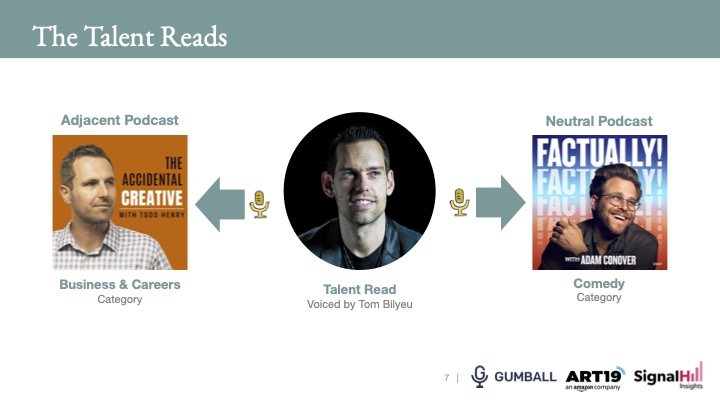Even with many new ad technologies in podcasts – from programmatic to contextual targeting – there remains a strong consensus in the industry that host reads are often most desirable. At the same time, they are the most challenging type of ad creative to scale.
One obvious limitation is that the creative may only appear in the host’s own podcast – that’s what makes it a “host” read. But, is that really absolutely necessary?
This is the research question we pursued in a study conducted in partnership with advertising marketplace Gumball and hosting platform Art19. Dane Cardiel, Gumball’s VP of Creator Partnerships, first brought the idea to Signal Hill founder Jeff Vidler well over a year before the study was launched.
Dane was motivated by the hypothesis that a host’s read might remain effective even when used on a different podcast. If so, there would be evidence to support using these creatives in run-of-network, programmatic and other impression-based campaign buys.
He called this strategy – using one podcast host’s ad read creative on a different podcast – a “talent read.”
Designing Strategic Brand Lift Thought Leadership
This is just the kind of creative challenge we love to tackle. It’s rewarding when we get the opportunity to conduct a thought leadership study that can help to advance innovation.
In everyday ad campaigns, research questions and insights often come second, behind the core objectives – like awareness or sales conversions – and simply getting the campaign launched.
To test Dane’s hypothesis, we looked at three different ad creatives – a host read, a talent read and an announcer read that we tested in three different podcasts. We also compared all of these results to a control – podcast content with no ad – so we could establish a baseline and establish the brand lift.
Listeners heard only one type of ad – host, talent or announcer – in only one podcast context – in either the host’s own podcast, in an adjacent category podcast or a neutral category
podcast.
We were fortunate to secure the cooperation of a host willing to lend his podcast and voice to this study, Tom Bilyeu of Impact Theory. He recorded a host read ad for Stamps.com to be used in his own show, along with a talent read we used in the other two shows. The copy for the ads was identical, except in the talent read Tom introduced himself and his show.
Because Impact Theory is in the business category, we selected another business show, The Accidental Creative with Todd Henry, as the adjacent podcast. Factually! With Adam Conover is a comedy podcast that filled the neutral podcast slot.

Art19’s sister company Wondery Studios provided a professional announcer read ad for Stamps.com that we tested in all three podcasts. The copy was identical to the host and talent read ads, though the announcer does not introduce himself.
For the study we recruited 800 podcast listeners to listen to one of the following:
- Host Read Ad – Tom Bilyeu on Impact Theory with Tom Bilyeu
- Talent Read Ad on an Adjacent Podcast – Tom Bilyeu on The Accidental Creative with Todd Henry
- Talent Read Ad on a Neutral Podcast – Tom Bilyeu on Factually! With Adam Conover
- Announcer Read Ad on Impact Theory, The Accidental Creative or Factually!
- No Ad (Control) on Impact Theory, The Accidental Creative or Factually!
In all, we tested nine variables so we could carefully separate and analyze the results.
Hypothesis Confirmed: How Talent Reads Perform for Podcasts
So, what did we learn?
We confirmed our hypothesis that a talent read ad would perform nearly as well as a host read ad. It also outperformed the announcer read.
However, it turns out we were correct to test two different genres of podcasts with the talent read. While Tom Bilyeu’s talent read drove strong lifts in Familiarity, Affinity and Purchase Intent for Stamps.com in the adjacent podcast, The Accidental Creative, that same exact ad did not have similar impact on Factually!, the neutral podcast.
For its part, the announcer read was an all-around solid performer in driving top-funnel metrics like Familiarity and Affinity across all three shows.
In the final analysis we concluded that a combination of all three ad types in a single campaign – host read, talent read and announcer read – is an efficient way to maximize both reach and upper funnel brand lift effectiveness.
We invite you to dig deeper into these findings and insights by downloading the full report:
The Power of Talent Reads in Podcasts.
Thanks go to Andy Slater and the Art19 team, and Ryan Chambers and the Gumball team for supporting and collaborating on this study. We’re also grateful to Tom Bilyeu for lending his voice and podcast, along with the whole Impact Theory team. And, of course, this study would not have happened without the vision and initiative of Dane Cardiel.




